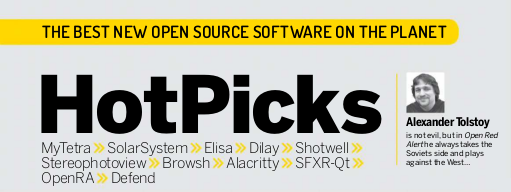Случайно узнал удивительную новость о том, что в сентябрьском номере журнала Linux Format (английская версия) в разделе "Самое лучшее программное обеспечение с открытым исходным кодом на планете" появилась статья про мой PIM-менеджер MyTetra.

Сама статья написана в классическом буржуйском утилитарном стиле, и рассказывает о MyTetra в сравнении с ПО, основанном на Linux-библиотеке доступа к персональной информации Akonadi (фреймверк, используемый в KDE). Неожиданное сравнение, хотя почему бы и нет. Сама статья выглядит так:

Увеличить
Текст следующий:
MyTetra
Version: 1.43.27
Web: https:// github.com/xintrea/mytetra_dev
It’s like a Wordpad with power-ups and project management features.
We would love to write endless praise for Akonadi, if only it didn’t crash from time to time, so in the meantime there is still a demand for a solid, stable and well-designed personal information manager (PIM) for Linux. Before taking MyTetra for a review spin, we Googled for existing PIM apps and after a while discovered that MyTetra may be not instantly the best, but it has some special features to offer and generally looks very strong.
Good things spring out from the moment you use it. In our memory MyTetra is the first app that asks if you want to store its data in ~/.config (standard behaviour) or in the current directory (portable version). The latter lets you take your notes with you anywhere on a USB flash drive, for instance.
The main window resembles the famous CherryTree note-taking app, for which we had a sweet tutorial in LXF237. Basically, there are three panels: the left one for the notes tree, the upper one for the inbox-like table view, and the main area for working with your documents. MyTetra has outstanding rich text editing capabilities that don’t leave you hanging, because MyTetra has everything a word processor should have, and in this regard it clearly outperforms CalligraWords (formerly KWord), the only dedicated Qt-based word processor. MyTetra lets you select fonts, their sizes and styles, change indents with a ruler, work with tables and cells, format your text as a numbered list and do many more things. Everything is stored using the HTML format, and you can even edit the code right in the application, as if it was a web composer!
What is where in MyTetra...
1. The tree of your notes
No matter how big your MyTetra library
is, you always see the entire structure here,
with all sibling and child items.
2. List of notes inside an item
Each element of the tree can hold more
than one note. You can check the entire list in
this table view.
3. Documents with rich formatting
It goes far beyond just playing with fonts.
Tables and images are also supported!
4. See what you get
Each note is an HTML document inside,
and here you can see its rendered preview.
5. Search the knowledge base
MyTetra diligently puts all your body texts,
titles and tags into a searchable index.
Apart from being a cross-platform application, MyTetra can be used as an online encyclopedia if you upload your mytetra.xml and other data files to a remote host. The project website contains instructions about the required steps with GitHub and Bitbucket used as example hosts. The MyTetra download page offers a static build for those who don’t want to compile the code themselves.
Как хорошо иногда продвигать свое ПО в интернет-сообществах! Достаточно было назвать MyTetra "Самой нужной программой не свете", как эстафета была подхвачена, и теперь она самая лучшая на планете. Так и до Мультивселенной недолго добраться.


 Поиск по сайту
Поиск по сайту

